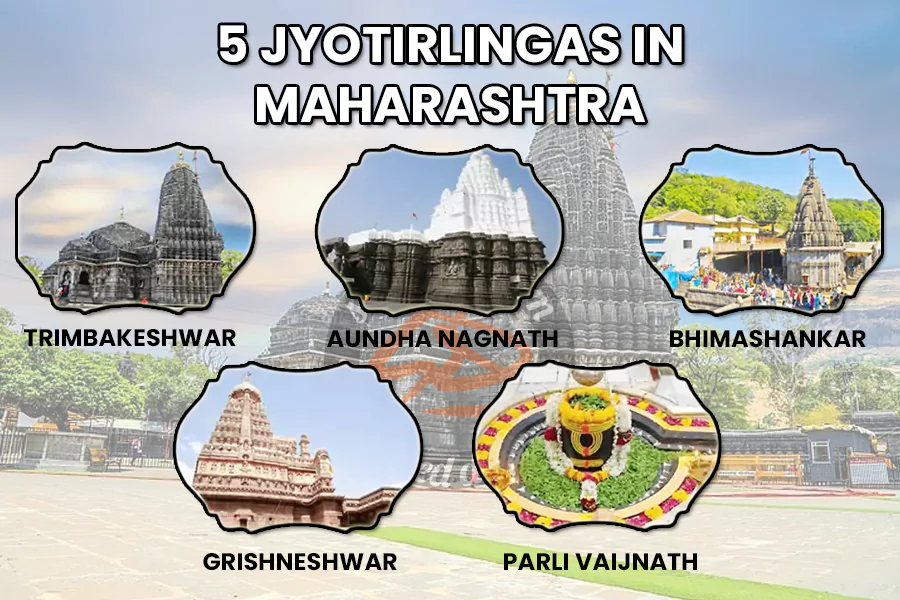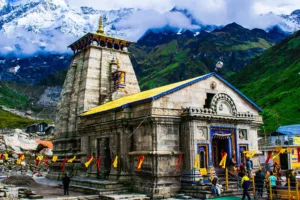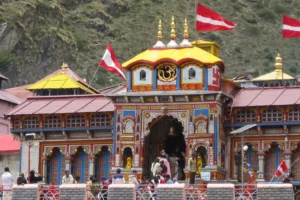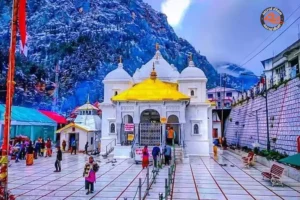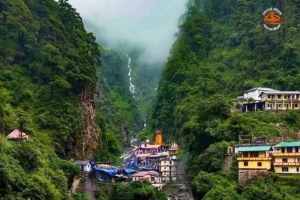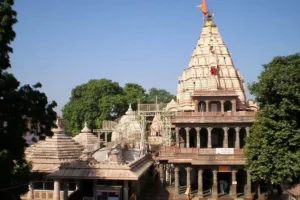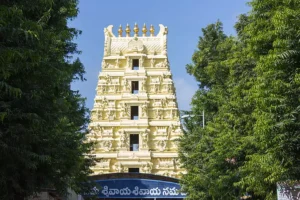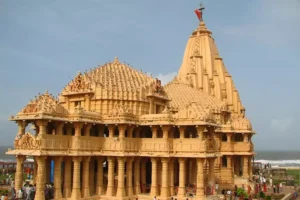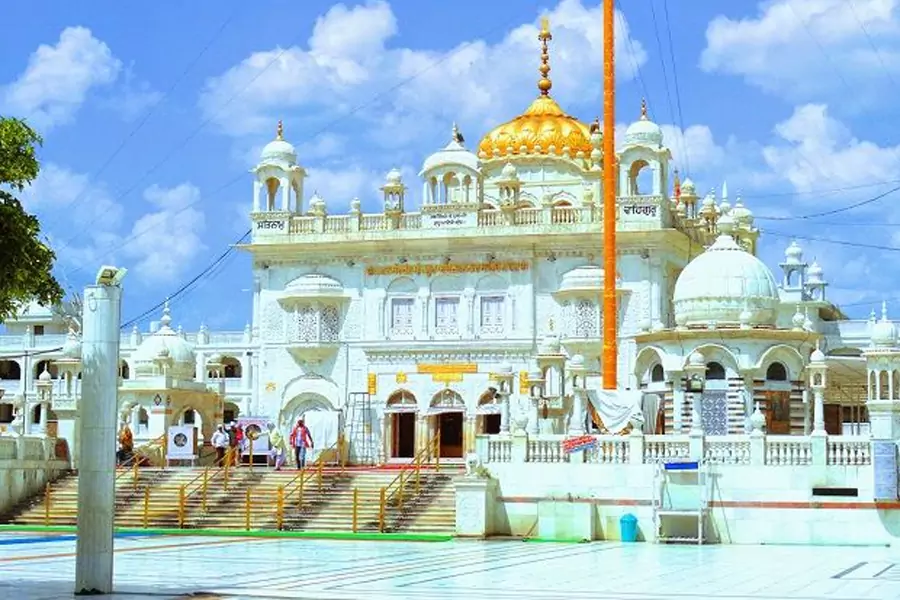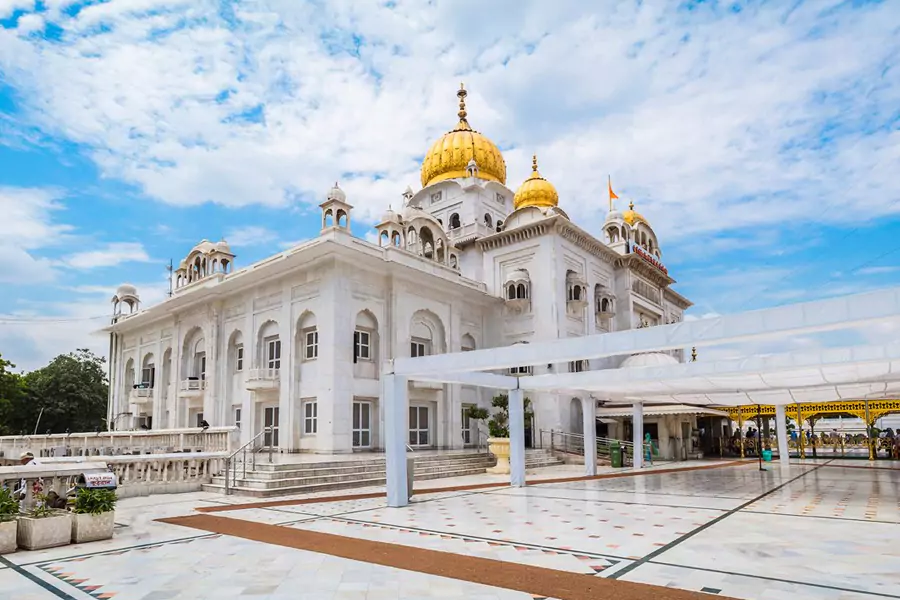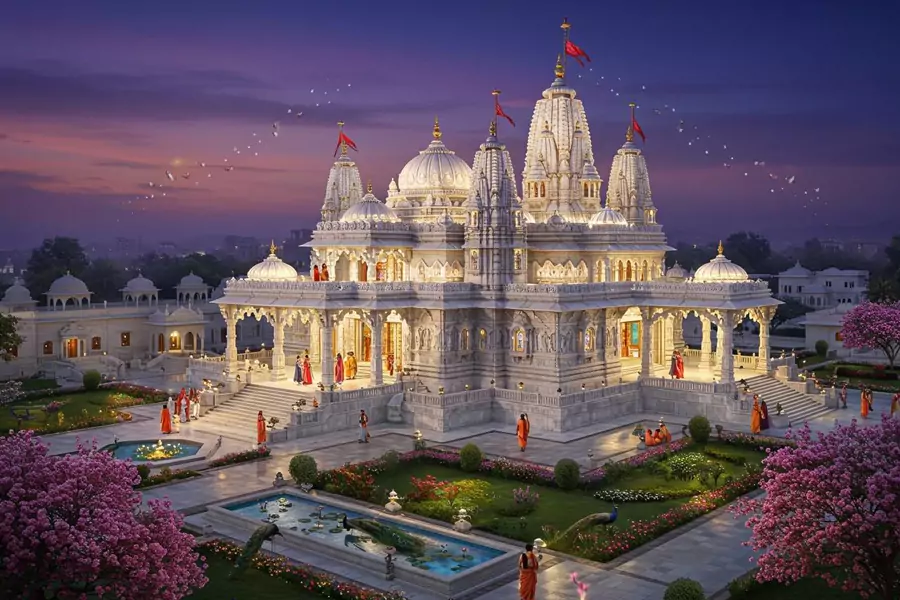The Jyotirlinga is regarded as Lord Shiva’s authentic or Swayambhu form. The term Swayambhu Linga refers to Lord Shiva’s manifestation as a Linga. There are a total of 12 Jyotirlingas in India. Among them, Bhimashankar, Trimbakeshwar, Grishneshwar, Nagnath in Aundha, and Parli Vaijnath are the five Jyotirlingas in Maharashtra. Collectively, these five sacred sites are known as the Pancha Jyotirlinga. Each temple is dedicated to the devotion of Lord Shiva. This blog highlights the significance of the five Jyotirlingas in Maharashtra.
Famous Five Jyotirlingas in Maharashtra
Explore the five revered Jyotirlingas in Maharashtra with this detailed travel guide.
|
5 Maharashtra Jyotirlinga Name |
Jyotirlinga Places in Maharashtra |
|
Trimbakeshwar Jyotirlinga |
Nashik |
|
Bhimashankar Jyotirlinga |
Pune |
|
Grishneshwar Jyotirlinga |
Aurangabad |
|
Aundha Nagnath Jyotirlinga |
Hingoli |
|
Parli Vaijnath Jyotirlinga |
Beed |
The 3 Jyotirlingas in Maharashtra
Maharashtra is a land of great spiritual significance, especially for devotees of Lord Shiva. Unlike most other states that feature one or two Jyotirlingas, Maharashtra is home to five of these sacred shrines. However, it’s important to note that only three of these five are part of the revered list of the 12 primary Jyotirlingas in India. The other two, Aundha Nagnath in Hingoli and Parli Vaijnath in Beed, although cherished by local communities, are not counted among the traditional 12.
Why Aren’t Aundha Nagnath & Parli Vaijnath Included in the 12 Jyotirlingas?
Aundha Nagnath and Parli Vaijnath, despite their religious importance, are not recognized as Jyotirlingas due to discrepancies in ancient scriptures and the variation in regional practices. The classification of Jyotirlingas differs across texts, leading to a distinction between the 12 major and other sacred shrines.
Let’s embark on a divine journey to discover the 5 Jyotirlingas in Maharashtra!
1. Trimbakeshwar Jyotirlinga, Nashik

The first temple on our checklist was the sacred Trimbakeshwar Jyotirlinga. Built in black stone, this architectural wonder stands near the Brahmagiri mountain beside the river Gautami, about 30 km from Nashik city. As we stepped inside, we joined streams of devotees arriving from every corner of India, their chants of ‘Har Har Mahadev’ filling the air with devotion and peace. The temple priest shared that Lord Shiva blesses this shrine along with Goddess Parvati, Goddess Lakshmi, and Goddess Saraswati.
Significance: It is said to be the origin of the Godavari River and is highly significant in Hindu mythology. The temple also has great importance for those performing the Narayan Nagbali and Kalsarpa Shanti pujas.
Best Time to Visit: October to March
Temple Timings: 5:30 a.m. to 9:00 p.m. (with multiple Aarti sessions)
How to Reach:
- Nearest Railway Station: Nashik Road Railway Station (approx. 28 km)
- Nearest Airport: Nashik Airport (31 km) or Mumbai Airport (200 km)
- By Road: Well-connected by road from Nashik, Mumbai, and Pune
Things to Do: Visit Kushavarta Kund (Godavari origin), take a holy dip, and explore nearby Anjaneri Hills, believed to be the birthplace of Lord Hanuman.
Attractions in and around: Brahmagiri Hill | Shri Navshya Ganpati | Sita Gufa | Kalaram Temple |Dugarwadi Waterfalls | Ramkund | Pandavleni Caves | Saptashrungi Temple | Panchvati | Harihar Fort
2. Bhimashankar Jyotirlinga, Pune

Our next destination was the Bhimashankar Jyotirlinga, located on the banks of the Bhima River in Pune, along the scenic Sahyadri mountain range. Surrounded by lush greenery, the temple delighted our eyes and lifted our spirit, while a holy dip in the Bhima brought deep calm to the soul. Even something as simple as buying offerings for Lord Shiva in the form of ‘Ardhnareeshwara’ from the local vendors outside the shrine filled me with pure joy.
Significance: According to legends, Lord Shiva took the form of Bhimashankar to defeat the demon Tripurasura. The temple is also the origin of the Bhima River.
Best Time to Visit: October to February
Temple Timings: 4:30 a.m. to 9:30 p.m.
How to Reach:
- Nearest Railway Station: Pune Junction (approx. 110 km)
- Nearest Airport: Pune International Airport
- By Road: Direct buses and cabs available from Pune and Mumbai
Things to Do: Explore Bhimashankar Wildlife Sanctuary, enjoy trekking routes, and witness mist-covered mountains during monsoon.
Attractions in and around: Datta Mandir | Ram Mandir | Hanuman Lake | Ahupe Waterfalls | Bhimashankar Trek
3. Grishneshwar Jyotirlinga, Aurangabad

Next, we visited the Grishneshwar Jyotirlinga, set beside an ancient pond called ‘Shivalay’ in the village of Verul, around 20 km from Daulatabad near Aurangabad in Maharashtra. I had earlier read that, unlike the other eleven Jyotirlingas, the Lingam here is built in a way that the water from the Abhishekam flows eastward. That day, during the temple rituals, I saw this unique feature with my own eyes.
Significance: The temple is a symbol of devotion and love, as it is said to have been restored by a devout woman named Kusuma who worshipped Lord Shiva despite hardships.
Best Time to Visit: October to March
Temple Timings: 5:30 a.m. to 9:30 p.m. (Aarti at regular intervals)
How to Reach:
- Nearest Railway Station: Aurangabad Railway Station (30 km)
- Nearest Airport: Aurangabad Airport (29 km)
- By Road: Easily accessible from Aurangabad city
Things to Do: Visit Ellora Caves (UNESCO World Heritage Site), Daulatabad Fort, and Bibi Ka Maqbara.
Attractions in and around: Ellora Caves | Ajanta Caves | Bhadra Maruti Temple | Bibi Ka Maqbara | Chhatrapati Sambhajinagar Caves |Devgiri Fort
4. Aundha Nagnath Jyotirlinga, Hingoli
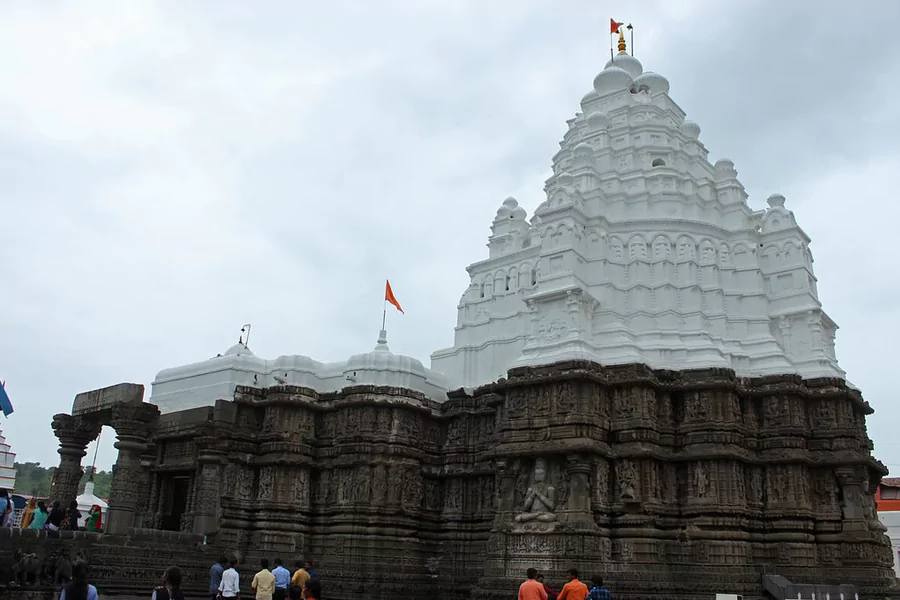
We then reached the ancient Aundha Nagnath Temple, considered the oldest Jyotirlinga, situated in the Hingoli district of Maharashtra. This sacred shrine draws countless devotees who believe that worshiping Lord Nagnath protects one from all kinds of poisons. What fascinated me most was the temple’s design—the sanctum lies in the basement, and we had to descend steps to offer our prayers to the deity.
Significance: It is believed that Lord Shiva lived here in the form of Nagnath during the Dwapar Yuga and that the Pandavas built this temple during their exile.
Best Time to Visit: October to February
Temple Timings: 4:00 a.m. to 9:00 p.m.
How to Reach:
- Nearest Railway Station: Hingoli Railway Station (approx. 50 km)
- Nearest Airport: Nanded Airport (135 km)
- By Road: Buses and taxis available from Nanded and Aurangabad
Things to Do: Explore the temple’s intricate carvings, attend local fairs, and experience rural Maharashtra’s spiritual vibe.
Attractions in and around: Tulaja Devi Sansthan Temple | Siddheshwar Dam | Mallinath Digambar Jain Temple
5. Parli Vaijnath Jyotirlinga, Beed

Our final stop was the Parli Vaijnath Jyotirlinga in Beed district of Maharashtra, a shrine surrounded by rich medicinal plants, which gives the temple its name. The serene atmosphere felt deeply healing, easing both worldly worries and the sadness of ending such a remarkable journey. This trip had given me not only the joy of travel but also a rare sense of oneness with Shiva. What struck me most was the tradition here—devotees are allowed to touch the Lingam, unlike most other temples. At Parli Vaijnath, where Lord Shiva is revered as ‘Vaidyanath’, it is believed that touching the Lingam aids in healing.
Significance: It is believed that Lord Vishnu once meditated here to heal himself from poison. Devotees visit to seek blessings for health and vitality.
Best Time to Visit: October to February
Temple Timings: 5:00 a.m. to 9:00 p.m.
How to Reach:
- Nearest Railway Station: Parli Vaijnath Railway Station
- Nearest Airport: Nanded Airport (110 km)
- By Road: Good road connectivity with Latur, Beed, and Nanded
Things to Do: Visit nearby waterfalls and hot springs, attend morning aarti, and explore Parli’s peaceful town life.
Attractions in and around: Dakshin Mukhi Ganesh Temple | Shri Someshwar Mahadev Temple | Shri Ratneshwar Mahadev Temple | Harihar Pilgrimage
5 Jyotirlinga in Maharashtra – Route Map:
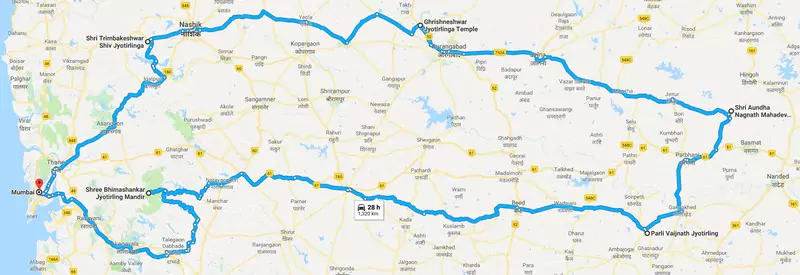
List of Other Jyotirlingas in India:
- Somnath Jyotirlinga: Located near Veraval in Prabhas Kshetra, Kathiawad district of Gujarat, this is one of the most revered shrines dedicated to Lord Shiva.
- Nageshwar Jyotirlinga: Also known as Nagnath Temple, it lies on the coastal route between Dwarka and Bet Dwarka Island in Saurashtra, Gujarat.
- Mallikarjuna Jyotirlinga: Found on the Shri Sailam Mountain along the banks of the Krishna River in Andhra Pradesh, this temple holds immense spiritual significance.
- Mahakaleshwar Jyotirlinga: Situated on the banks of the Kshipra River within the Mahakal forest of Ujjain, Madhya Pradesh, this shrine is among the most powerful centers of Shiva worship.
- Omkareshwar Jyotirlinga: Set on Mandhata, also known as Shivapuri Island, in the Narmada River, this Jyotirlinga in Madhya Pradesh is admired for its sacred setting.
- Vaidyanath Jyotirlinga: Located at Deogarh in the Santal Parganas of Jharkhand, it is believed that worship here grants relief from ailments and suffering.
- Rameshwaram Jyotirlinga: Found on Rameshwaram Island in Tamil Nadu, this temple is a vital pilgrimage site and part of the Char Dham circuit.
- Kedarnath Jyotirlinga: Perched on the Rudra Himalayan Range at an elevation of about 12,000 feet on Mount Kedar, it remains one of the most sacred and challenging pilgrimages.
- Kashi Vishwanath Jyotirlinga: Located in Kashi (Varanasi or Banaras), one of the world’s oldest living cities, this temple is considered the spiritual heart of India.
Most Frequently Asked Questions?
Q1: How many Jyotirlingas are there in Maharashtra?
A: Maharashtra is home to 5 Jyotirlingas: Trimbakeshwar (Nashik), Bhimashankar (Pune), Grishneshwar (Aurangabad), Aundha Nagnath (Hingoli), and Parli Vaijnath (Beed). Each temple holds deep spiritual and mythological significance for Lord Shiva devotees.
Q2: Which is the most visited Jyotirlinga in Maharashtra?
A: Trimbakeshwar and Bhimashankar are among the most visited due to their accessibility and scenic surroundings.
Q3: Can I visit all 5 Jyotirlingas in a single trip?
A: Yes, but it may take 7–10 days. It’s advisable to plan based on distances and available transportation.
Q4: Are there accommodations near these temples?
A: Yes, all five temple towns have hotels, lodges, and dharamshalas ranging from budget to premium.
Q5: Is there a specific order to visit the Jyotirlingas in Maharashtra?
A: There is no fixed order, but many start with Trimbakeshwar or Bhimashankar due to proximity to major cities.
Conclusion
The 5 Jyotirlingas in Maharashtra are not just religious destinations—they are spiritual powerhouses where faith, nature, and history converge. Each temple offers a unique experience, from the tranquil forests of Bhimashankar to the ancient carvings of Aundha Nagnath. Whether you’re a devout follower of Lord Shiva or a curious traveler, this sacred journey will leave your soul enriched.
So, plan your visit, follow temple etiquette, and let these holy shrines transform your spiritual path. For more divine destinations, explore our guide to famous temples in India.


